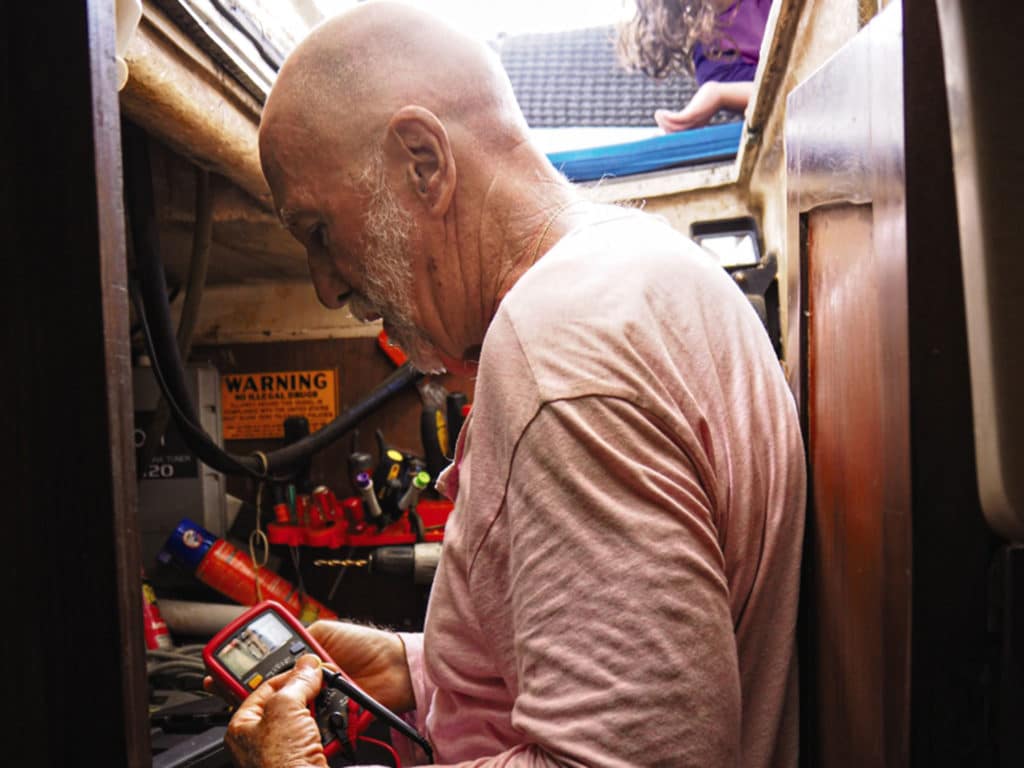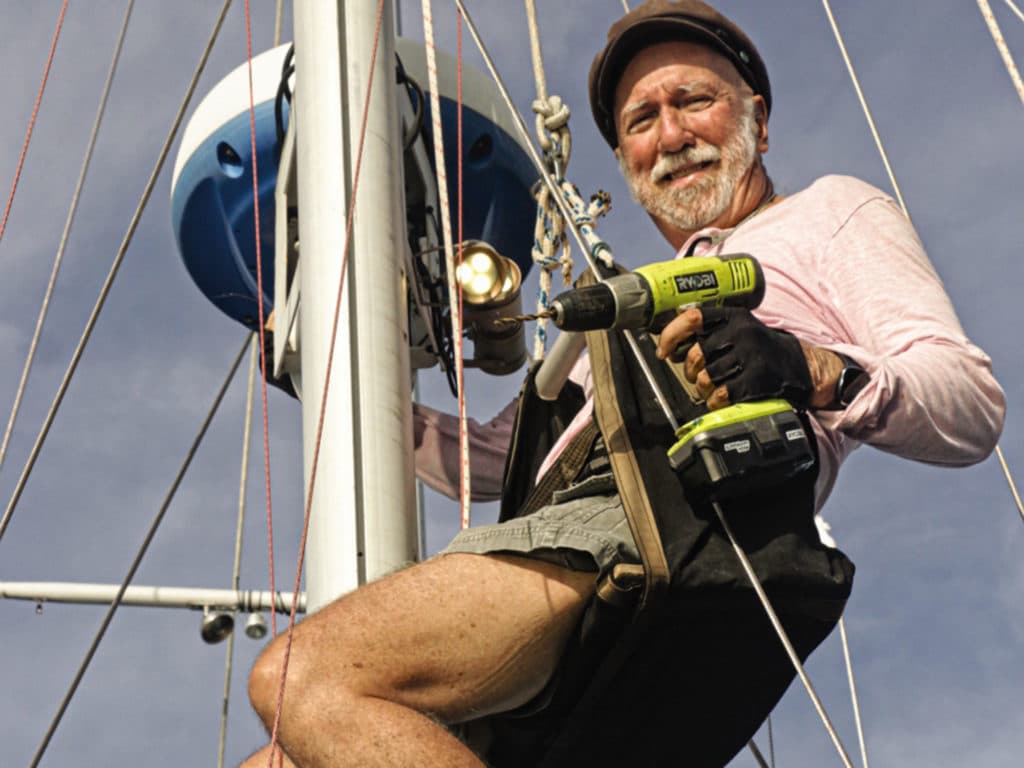
COVID-19 has taken away much, but at the same time, it has given us vast stretches of uninterrupted time. I’ve used mine to catch up on my reading and to putter around my boat electrically. Since we’re particularly blessed with cheap LED components here in Southeast Asia, where my wife, Carolyn, and I are sitting out the pandemic aboard our Wauquiez ketch, Ganesh, I started out by focusing on lighting.
We now have nearly hidden red night lights gently illuminating our teak-and-holly cabin sole. They’re on two switches just inside the companionway. One we use if we’re headed forward from our amidships cockpit, the other if we’re going aft through the walk-through into the aft cabin. Obviously, both circuits are independently fused and the wires loomed away from any water or dampness. Each LED bulb is placed behind something—a door, bulkhead lip or ledge—so that coming below at night, we don’t see bulbs directly, only the glow of faint red illumination.
The new lighting makes it easier and safer to move around the boat at night in a seaway and helps preserve our night vision. It has the added benefit of making our varnished mahogany interior look stunning.
Speaking of our walk-through, it is quite dark in this area and easy to trip on steps built into the sole. It’s an airless, stuffy part of the boat, and we had replaced the sea bunk there with our offshore safety gear. The Paratech sea anchors, Jordan series drogues and various other slowing devices (and their rodes) take up a lot of space. Anyway, the bottom line is that this area not only needed gentle red illumination that preserves our night vision while we transit it, but also bright illumination if we need to access our portable Edson bilge pump, our ditch bag or our three dry bags of life-raft supplies. The problem is that anywhere you put a light switch would be wrong. The solution was a double-pole double-throw switch that can be turned on and off at either end of the passageway.
Too posh? Perhaps, but kind of cool as well. Why not do projects and make repairs that make you smile? (Actually, our 43-foot cruiser had something like this as original equipment, we just had to replace the switches and run new wires.)
Since we have little money, we do a massive amount of entertaining aboard for two reasons: One, we can control the cost, and two, we can repay the favors done by others who picked up a bar tab or paid for dinner ashore.
The good news is that our folding cockpit table is massive and sits six, but illuminating it wasn’t easy. To correct that, we used a strip of warm-yellow LEDs that now spreads the illumination and still allows the food to look good. Carolyn isn’t merely a good cook—her dinners are as visually pleasing as they taste. And I like to see my food, so this strip is fairly bright.
After dinner, however, we switch it off and turn on a single, softer warm-yellow LED cocktail light, which is totally waterproof as well. As an aside, I’ll say that dim lights and romance go hand in hand, especially at 70 years of age.
I’ve installed a 360-degree anchor light on our mizzen that automatically turns on at dusk and shuts off at dawn.
Since we regularly sail in the Indian Ocean, our cockpit is often awash and fire-hosed by breaking seas, so using top-quality waterproof components here is a must. I not only use heat-shrink terminals, but I also put an additional, longer piece of heat shrink over them so I have double the chance of keeping out the aerated salt crystals that eventually cause bad electrical connections.
From time to time, we have to throw our rum-guzzling friends back into their dinghies at some point in the evening. Now we have a dedicated mizzen LED spotlight that shines down on the aft deck area by our stern ladder. In addition, our stern light is mounted on our transom and arranged in such a manner that it illuminates the dinghy and the ladder as visitors board or tipsily debark.
Just in case we pass out with relief once our guests leave, I’ve installed a 360-degree anchor light on our mizzen that automatically turns on at dusk (or even during dark squalls) and shuts off at dawn. This is in addition to our brighter main masthead light, which is manually switched.
Because we spend so much of our time in the tropics, all of our boats have featured fans at the berths, galley and nav station. In the name of efficiency, we use cageless 12-volt fans with on/off switches conveniently located so that our sleepy fingers don’t get bitten by the spinning blades.
At this point in our lives, we’re more interested in small projects with immediate benefits.
In both heads we have a normal light, a reading light and a muffin, or computer exhaust fan, to carry away odors.
Strangely, since we often sail in high winds, our windspeed instrument is both dirt cheap (it’s a nonmarine Maximum) and manually switched. Yes, I want to occasionally know the windspeed during a gale, but only at times. The last thing I need is for nervous guests to watch the wind gust into the 40-knot range and have their blood pressure rise with the breeze.
Since we’ve lived most of our lives at anchor near islands in developing nations, we have a panic button—a doorbell, really —by the side of my pillow. The idea here is to passively and non-confrontationally scare away boarders before they get below, especially if they’ve swum out to our boat with a machete in their teeth. This button unleashes loud sirens and bright strobes at both the companionway and on the mizzen mast. I’ve used them four or five times over the years, and they are so bright and loud, they are panic-inducing. I’ve found that they’re particularly effective if da teef’s dinghy has just “touched” our hull and the bad boys are still in it.
Since we earn our pennies as we sail, we have to have our computerized tools conveniently with us wherever we work. We have 5-volt chargers in the aft cabin, saloon, nav station, tool room and cockpit. Whew! We’ve gone on daysails with eight or 10 executive-type paper pushers, and just keeping up with their iPhone charging needs is a full-time job.

While we now use wireless Bose portable speakers in our cockpit for music, we just installed a removable RAM3 remote mic and speaker there for our Horizon VHF radio. We seldom chat on our VHF, buddy boat or convoy with other cruisers, but I find that having a cockpit speaker and remote mic is extremely useful during boat-to-boat rescues or in other situations where immediate communication becomes necessary.
Meanwhile, down below, we now have two lights in our engine room. One provides soft light that we use when routinely checking our fluids; the other is a bright one in case we’re chasing a major mechanical problem or leak.
In addition to the panic alarm I mentioned earlier, we also rely on our $17 burglar alarm system, though not while in Singapore, because in this city-state of 6 million people, we never lock our vessel, dinghy or even our bikes. How crime-free is S’pore? To reserve a table in one of the busy food courts, elderly male Singaporeans will leave their iPhone to mark their spot, while the ladies just drop off their purse amid the sea of strangers. Ah, Singapore is utterly amazing. The last item that went missing off a boat at the Changi Sailing Club was just after World War II!
However, while cruising Malaysia, Indonesia and Thailand, we do set our burglar alarm as we leave our often-solitary anchored vessel. Thus, we feel the $17 dollars we gave Amazon was well-spent for the relay timer that automatically shuts off all our bells, sirens and strobes after five minutes of unbearable racket. The alarm is triggered by a high-tech pressure-sensitive switch made from two broken sail battens wrapped in copper that make contact as you step into our cockpit. We also have a trip thread at the boarding ladder that we can add if we’re in a particularly worrisome area.
Here’s the truth of it: I’ve built entire boats from a few sheets of paper plans, and I’ve made expensive repairs to other vessels. Sailboats are complicated, and maintaining them is time-consuming. But there’s nothing like sailing across an ocean on a vessel that was once just a glimmer in your eye as you stared at a distant horizon. At this point in our lives, however, we’re more interested in small projects with immediate benefits. We need gentle lights to hide our wrinkles. Most of these projects cost almost nothing, only time. Carolyn and I often work on them together. Romance, after all, can be fostered while stripping wires as much as anything else.
And we keep our sense of humor while doing so. Every time I ask my wife a question, she says, “Watt?” As former hippies, we love our om-meter. Nothing impedes us. Don’t be shocked; we still get a charge out of making each other smile.
Fatty and Carolyn Goodlander report that they are beginning to go stir-crazy sitting aboard Ganesh in Singapore in Year Two of the pandemic.








